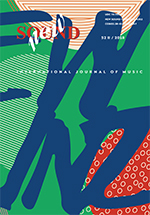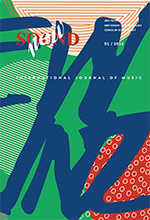Issue No. 41
Composer/Musicologist Speaks
Tijana Popović Mlađenović – LIVING ONE’S OWN THOUGHT EXPERIENCE WITH MUSIC AND MUSICOLOGY – INTERVIEW WITH MIRJANA VESELINOVIĆ́-HOFMAN
Download: ser / eng
Studies
Milan Milojković – AESTHETICAL VIEWS OF VOJISLAV VUČKOVIĆ IN THE LIGHT OF THEORY OF REFLECTION AND CRITICAL THEORY
Abstract: Although Vojislav Vučković (1910–1942) did not leave an elaborate and self-contained theoretical system behind, his creativity can nevertheless be perceived from a relatively integral perspective, thanks to collections of papers published posthumously. It should be kept in mind that our great composer lost his life at the pinnacle of productivity; hence, we can safely say that his work was interrupted in every sense of the word, and thus left somewhat fragmentary. There is a very significant difference between the views on problem solving he advocated in his early essays and those he promoted before and during the war, given that the timespan involved is just ten years (1932–1942). Based on these ‘theoretical wanderings’, one could assume that Vučković was following the intensive changes on the West European theoretical stage of his time, endeavouring to shape his standpoints in a dialogue with the main theoretical currents.
Keywords: Vojislav Vučković, Theodor Adorno, Walter Benjamin, critical theory, theory of reflection, aesthetics of music.
Download: ser / eng
Lidia Ader – MICROTONAL RUSSIA: 1950–1970s MYTHS AND REALITIES
Abstract: The Russian history of new music in the 20th century could be called ‘impulsive’. There were powerful stimuli, given by Western music which Russian composers did or did not, however, respond to. In my article, I am going to discuss some mechanisms of the historical development of microtonal music in Russia 1950–1970s in comparison to what was produced at the beginning of the century.
Download: ser / eng
Selena Rakočević – TRACING THE DISCIPLINE: EIGHTY YEARS OF ETHNOCHOREOLOGY IN SERBIA
Abstract: The interest for traditional dance research in Serbia is noted since the second part of the 19th century in various ethnographical sources. However, organized and scientifically grounded study was begun by the sisters Danica and Ljubica Janković marked by publishing of the first of totally eight volumes of the “Folk Dances” [Narodne igre] in 1934. All eight books of this edition published periodically until 1964 were highly ac- knowledged by the broader scientific communities in Europe and the USA. Dance research was continued by the following generation of researchers: Milica Ilijin, Olivera Mladenović, Slobodan Zečević, and Olivera Vasić. The next significant step toward developing dance research began in 1990 when the subject of ethnochoreology was added to the program of basic ethnomusicological studies at the Faculty of Music in Belgrade and shortly afterward in 1996 in the Academy of Arts in Novi Sad. Academic ethnochoreological education in both institutions was established by Olivera Vasić.
The epistemological background of all traditional dance research in Serbia was anchored mostly in ethnography focused on the description of rural traditions and partly in traditional dance history. Its broader folkloristic framework has, more or less, strong national orientation. However, it could be said that, thanks to the lifelong professional commitment of the researchers, and a relatively unified methodology of their research, ethnochoreology maintained continuity as a scientific discipline since its early beginnings.
The next significant milestone in the development of the discipline happened when traditional dance research was included in the PhD doctoral research projects within ethnomusicological studies at the Faculty of Music in Belgrade. Those projects, some of which are still in the ongoing process, are interdisciplinary and interlink ethnochoreology with ethnomusicology and related disciplines.
This paper reexamines and reevaluates the eighty years long tradition of dance research in Serbia and positions its ontological, epistemological and methodological trajectories in the broader context of its relation to other social sciences/humanities in the contemporary era of interdisciplinarity and postdiciplinarity.
Keywords: dance research, ethnochoreology, Serbia.
Download: ser / eng
Iva Nenić – DISCRETE CASES: FEMALE TRADITIONAL MUSIC PLAYERS IN SERBIA
Abstract: This paper explores the exclusion of female traditional music players in Serbia and in the Balkans from the official representational discourses, frequently based on the assumption that women were not equal participants, but rather atypical or isolated ‘cases’ in the rural music cultures of the 19th and mid-20th centuries. Drawing on historical sources, and with a special focus on two short case studies of historical female gusle performers, the author strives to demonstrate how the workings of certain discourses, both in cultural and in scholarly terms, prepared today’s position for folk and neo-traditional music performers of the female gender, by stripping them of the history of female musicianship.
The trope of ‘being the only woman of her kind’, mannish and/or unusual, can be traced through the early folklorist and ethnographic depiction of female musicians, which was frequently supplemented with the deliberate stressing of alleged ‘female’ attributes of a performer. The paper also opens the question of gender approach in ethnomusicology, claiming that it should lead to the recuperation of the field in terms of scientific auto-critique and ‘ethnomusicological revisionism’.
Keywords:
woman guslar, ethnomusicological revisionism, Stevanija Dragaš, gender transgression, music.
Download: ser / eng
New Works
Stefan Cvetković – ALEKSANDAR OBRADOVIĆ – PRO LIBERTATE CONCERTO FOR PIANO AND ORCHESTRA NO. 3
Abstract: The Third Piano Concerto by Aleksandar Obradović, composed in 1999, is one of the author’s late works. While the poetical concept of the composition reflects the author’s personal reaction to the events from that period, aesthetically it shows that the coexistence of different compositional and technical patterns is possible, amalgamated within a unique stylistic procedure of the work. According to its compositional and technical procedures, the concerto belongs to the class of neoclassical pieces which, apart from confirming Obradović’s openness towards various musical solutions, attests to resorting to designs that stem from an extramusical stimulus to creativity.
Keywords: Serbian music, Aleksandar Obradović, piano concerto, Neoclassicism.
Download: ser / eng
Dragana Jeremić Molnar – SELF-PARODICAL CONSEQUENCES OF OPERATIC PARODY
Abstract: With rare exceptions, the critical response to the opera The Perfect American, whose protagonist is Walt Disney, was lukewarm. For the most part, the critics blamed its modest result on Rudy Wurlitzer’s libretto, described as incoherent, dramatically limited and lame, even boring. The input of the composer Philip Glass, the most distinguished name in the artistic team that created The Perfect American, received higher marks, but even those who praised some of his compositional solutions (and especially his trade skills) unanimously concluded that the music nevertheless had not reached a high enough level to compensate for the deficiencies in the libretto. In the interpretations available so far, the opera was generally understood to be a (failed) attempt at depicting Disney as an insufficiently talented person with an idea, who built his empire by shamelessly appropriating the merits of those who, thanks to their talents, were able to carry out his idea. The author in this text wants to show that the opera can be perceived in quite a different way: as an allegory of contemporary American culture, torn between its cosmopolitism and humanistic openness, on the one hand, and provincialism and parochial rigidity, on the other; this duality is encapsulated in Disney’s character per se, hiding behind a porous façade of perfection. The text reads that Glass’s music did not succeed in supporting this dimension of Wurlitzer’s libretto, thus inadvertently adding a self-parodical layer to its parodical content. Since the composer failed to come to grips with the dramatic challenges he was facing, the music constantly circled in a hiatus between bold avant-garde pretensions and hackneyed forms of minimalist mannerism.
Keywords: Glass, Disney, America, opera, minimalism.
Download: ser / eng
Analyses
Man-Ching Yu – TRANSFORMATIONS OF DIATONIC MATERIALS AND TONAL PROCEDURES IN LIGETI’S ETUDE NO. 15 “WHITE ON WHITE”
Abstract: This essay examines interrelationships of various diatonic materials that arise in Ligeti’s Etude No. 15 “White on White,” focusing on transformational properties between different diatonic trichords. Ligeti’s distinctive treatments of diatonic materials reflect the utilization of triadic intervallic structures in transformational procedures. In particular, ic5 dominates in abundance, contributing to the consonant tonal property between various pitch-class transformations among trichords, and that some are smoothly interconnected by common tones for preserving diatonic coherent sound. Additionally, some transformations are analogous to tonal procedures – harmonies progress from tonic to dominant or subdominant and vice versa – that manifests Ligeti’s pronounced reference to the context of the traditional common practice as three pitch-classes among the same types of trichords map onto each other solely by ic5. Along with the coherent diatonic sound that Ligeti forges, tonal contrasts are achieved through simultaneous tonal occurrences being established by transformed pitch-classes, forming tonal pairings in third relationship with ics 3 and 4 that illuminate the traditionalistic tonic and mediant linkage prevailing in the nineteenth century.
Keywords: Ligeti, transformation, double transformation, common tone, diatonic trichord, diatonic collection, micropolyphony, harmonic net-structure, tonal pairing, interval-class.
Download: ser / eng
Students' Papers
Marija Maglov – THE VIENNA NEW YEAR’S CONCERT AS A MEDIA PHENOMENON
Abstract: This paper is aimed at drawing attention to the problem of the media representation of artistic music, through the case study of the television broadcast of the New Year’s Concert in Vienna. The text contains a brief historic summary of the concert and its broadcast within the European television network, Eurovision. Using this year’s broadcast (2013) as an example, certain aspects are marked that potentially represent a starting point for further interpretations of the New Year’s Concert and, generally, the relationship between artistic music and media.
Keywords: the New Year’s Concert in Vienna, Eurovision, public broadcaster, media representation of class, media.
Download: ser / eng
Festivals and Symposia
Stefan Cvetković – FESTIVAL KoMA 8.5 AND 9
Download: ser / eng
Reviews
Ana Kotevska – Releases of FMU, Belgrade. Irina Arsikin, CD 1 / CD 2.
Dušan Trbojević, Antologija srpske klavirske muzike / Retrospektiva / Anthology of Serbian Piano Music / Retrospective, CD 1 / CD 2. FMU 002, Fakultet muzičke umetnosti, Belgrade / Sebia
Download: ser / eng
Ivana Petković – Petar Konjović: Ženidba Miloševa [The Wedding of Miloš] and Seljaci [Peasants], Double Compact Disc. EDITION PROBUĐENI ARHIV [AWAKENED ARCHIVE]. Released by Musicological Institute of SASA, Radio Belgrade Broadcasting Corporation, Institute of Textbook Publisihng, Belgrade, 2012
Download: ser / eng
Marina Marković – Predrag Miodrag: OGLEDI O SRPSKOJ CRKVENOJ MUZICI [ESSAYS ON SERBIAN CHURCH MUSIC]. Belgrade, Visoka škola – Akademija Srpske pravoslavne crkve za umetnost i konservaciju, 2012, 276 pages
Download: ser / eng
Nico Schüler – Vesna Mikić, Ivana Perković, Tijana Popović Mlađenović, and Mirjana Veselinović-Hofman: Between Nostalgia, Utopia, and Realities. Belgrade, University of Arts in Belgrade, 2012. Musicological Studies: Collections of Papers, vol. 4. ISBN 978-86-88619-17-2. 400 pages
Download: ser / eng
Defended Theses
Sanda Dodik – CONNECTION BETWEEN ARCHAIC AND MODERN SOUND IN THE CYCLE OF THE MUSIC OF OCTOECHOS BY LJUBICA MARIĆ
Download: ser / eng


